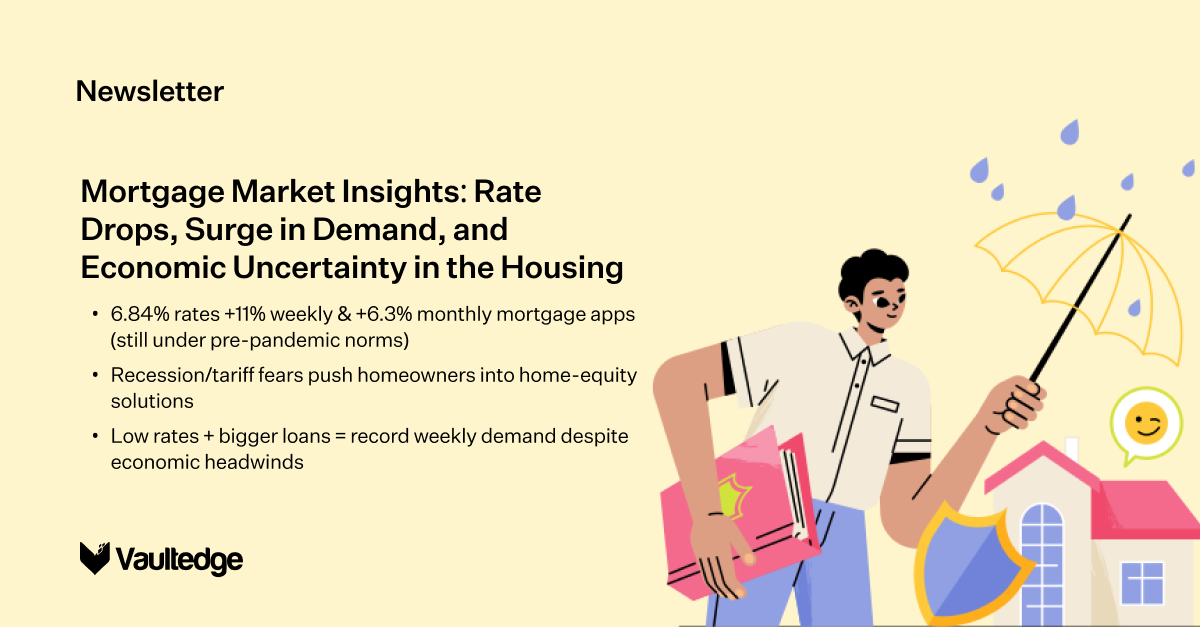Mortgage Market Insights: Rate Drops, Surge in Demand, and Economic Uncertainty Shaping the Housing Landscape
Mortgage Market Trends: Rate Changes, Surge in Demand, and Economic Uncertainty Reshaping the Landscape
What's Included:
A slight drop in mortgage rates to 6.84%, sparking an 11% increase in purchase and refinance activity.
Mortgage applications rose 6.3% due to the recent decline in interest rates, but still remain below pre-pandemic levels.
Homeowners are exploring home equity solutions due to economic uncertainty and tariff concerns, with many fearing a potential recession.
Weekly mortgage demand surged, with an 11% week-over-week increase in applications, driven by lower interest rates and larger loan sizes despite economic challenges.
Here’s a complete low-down 👇
Before you move on …
We would love, if you could subscribe to our newsletter.
Mortgage Rates Fall to 6.84%—Could 6% Be the Next Stop?
Mortgage rates ticked down slightly ahead of the Federal Reserve’s upcoming meeting, bringing a glimmer of relief to buyers and refinancers alike. The 30-year fixed mortgage rate slipped 5 basis points to 6.84% as of May 2, according to the Mortgage Bankers Association. That drop helped spur a surprise 11% jump in purchase and refinance activity, even amid ongoing economic uncertainty tied to tariffs and weak data.
So, could rates actually fall to 6%? Experts are skeptical. Bankrate’s Greg McBride notes that meaningful declines require either a sharp drop in inflation or significant economic weakening—neither of which are materializing yet. Adam Phillips of EP Wealth Advisors believes a sub-6% rate is unlikely before 2026 unless the economy takes a serious downturn, which might hurt affordability rather than help it.
Realtor.com’s Danielle Hale offers a more hopeful outlook—if inflation falls to 2%, the labor market holds, and economic growth continues, the Fed could ease policy. But with Trump-era tariffs clouding the picture, experts agree: while the dip is welcome, mortgage rates are unlikely to plunge soon without broader shifts in economic conditions….Read More.
Mortgage Applications Surge as Interest Rates Dip: A Market Rebound in Focus
Mortgage applications saw a notable uptick last week, marking the first increase in four weeks, as interest rates experienced a slight decline. According to the Mortgage Bankers Association (MBA), the Market Composite Index, which tracks mortgage application volume, rose by 6.3% on a seasonally adjusted basis for the week ending May 5. This surge was driven by both purchase and refinance applications, with the 30-year fixed mortgage rate dipping to 6.48%, down from 6.50% the previous week.
The increase in mortgage activity is attributed to the recent easing of mortgage rates, which have been declining for several weeks. The average 30-year fixed-rate mortgage ended the week at 6.48%, down 0.2% from the week before. This drop in rates has made home loans more affordable, encouraging more prospective buyers and homeowners to apply for mortgages.
Despite the positive trend, mortgage applications remain below levels seen during the pandemic-era housing boom. However, the recent data suggests a renewed interest in the housing market, particularly as the Federal Reserve signals a potential pause in interest rate hikes. This development may provide further momentum for the housing market in the coming weeks….Read More.
Navigating Financial Uncertainty: How Tariffs Are Driving Homeowners to Seek Equity Solutions
Recent trade policies have left homeowners anxious about their financial stability. A survey by home-equity investment platform Point revealed that 74% of consumers fear tariffs could raise the costs of foreign goods, potentially straining their finances in the next year. Additionally, 82% anticipate a U.S. recession, with 42% feeling uncertain about their personal finances—a significant increase from 36% the previous year.
This economic uncertainty has prompted many homeowners to explore alternative financial solutions. With 68% reporting six months or less in savings, and one-quarter having less than a month's worth, the need for accessible financial options is pressing. Home equity lending is emerging as a viable option, allowing homeowners to leverage their property's value to secure funds without selling. This approach provides a safety net amidst rising costs and market volatility.
Experts suggest that while tariffs may not immediately affect prices, the anticipation of future increases is influencing homeowner behavior. The combination of economic uncertainty and limited savings is driving a shift towards home equity solutions, offering homeowners a proactive way to manage potential financial challenges….Read More.
Weekly Mortgage Demand Jumps Amid Economic Uncertainty: What’s Driving the Surge?
Despite ongoing economic uncertainty, weekly mortgage demand has surged, as interest rates for 30-year fixed mortgages dropped slightly. The average rate decreased from 6.89% to 6.84%, encouraging more homebuyers to apply for mortgages. According to the Mortgage Bankers Association, applications for home purchases rose by 11% week-over-week, with a 13% increase compared to the same week last year. This surge came amid mixed economic news, including a negative GDP growth reading and a solid employment report.
The increased demand for mortgages, especially for conventional loans, comes as a surprise given the lingering economic concerns. Many buyers are still wary of making major financial commitments due to economic pressures, including potential tariff impacts and recent volatility in the stock market. However, larger loan sizes and a willingness to buy more expensive homes have driven the demand. Additionally, refinances also saw a rise, up 11% for the week, with Veterans Affairs (VA) loans showing the largest increase.
Although mortgage rates have stabilized this week, the outlook remains uncertain. The upcoming Federal Reserve meeting could shift rates depending on any unexpected remarks from Chairman Jerome Powell, keeping homebuyers and industry professionals on edge…Read More.
That’s a wrap for this week’s edition. Stay updated on the latest trends in mortgage rates, market demand, and economic uncertainty. Subscribe now to stay ahead in the ever-changing mortgage landscape—all in one place.




